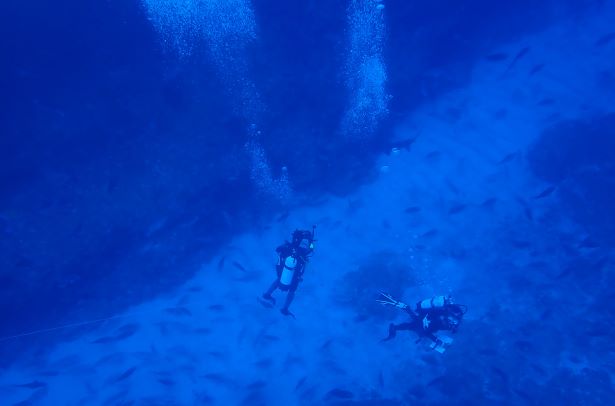There are glimmers of hope for the critically endangered Nassau grouper, a species which despite seasonal closures and size restrictions continue to experience declines throughout The Bahamas and the Caribbean.
Dedicated protection and conservation efforts have led to positive changes at some breeding sites — also called fish spawning aggregations (FSAs) according to Dr Krista Sherman, senior scientist at the Perry Institute of Marine Science (PIMS).
“The Hope Town FSA, which is in a remote location, is relatively healthy — supporting thousands of Nassau grouper. This is good news. It’s encouraging after documenting declines at several other historic FSAs over the past decade where aggregations either no longer form or have been drastically reduced, which is the case around Andros and Long Island.”
PIMS, a non-profit marine research and conservation organization, has been using a variety of techniques to identify active spawning sites, monitor Nassau grouper abundance during and outside of the spawning season, map FSAs and understand how their populations are structured and connected throughout the archipelago.
Collectively, these data provide much-needed information to guide sustainable management of a species listed as critically endangered by the International Union for Conservation of Nature (IUCN).
“My main goal is for us to see the Nassau grouper population begin to rebound,” said Dr Sherman. “I would like to see this downward trend stop. That would be the best thing for the fishery, the health of reefs and the species. But that’s going to require a lot of work and a lot of cooperation from everyone”.
The Nassau grouper season closes from December 1 to February 28. During that period "no person shall take, land, process, sell, or offer” the fish for sale “except where such taking or landing is carried out, with the written approval of the director of fisheries for scientific research purposes," according to the law.
The timeframe, however, only covers a portion of the species’ reproductive season. The spawning window for Nassau grouper in The Bahamas runs from November to March. Making matters worse, the predictability of when and where the annual fish spawning aggregations occur makes the species extremely vulnerable to overfishing.
“It would be ideal to protect the species during the entire period where they are actually breeding and migrating to spawn. Unlike other fish, this species has a very specific timeframe to reproduce that’s also influenced by the cycle of the moon, so it’s really a short period of time,” Dr Sherman explained.
“Although these fish are releasing lots of eggs and sperm not all of them successfully survive to adulthood. Predation and mortality can be high in their early life stages. Anything we can do to reduce threats to the species is critical. Ensuring that we are not destroying the habitats that they need throughout their life cycle and supporting regulations such as the minimum size limit and closed season which allows them to participate in spawning before they’re caught is crucial.”
Thanks to the generosity of Wayne Sullivan, in December, Dr Sherman and fellow researchers, Dr Valeria Pizarro and Michael Sherratt completed roving diving surveys to estimate abundances and sizes of Nassau grouper, and document and quantify spawning behavior. They took photographs and short video clips to assist with validating their estimates.
There are more than 40 reported breeding sites for Nassau grouper in The Bahamas. The research team has only surveyed a fraction of them. Through the years they have been hampered by budgetary constraints as well as cold fronts which can create unsafe diving conditions.
Thus far, PIMS has focused its work on sites around Long Island, Andros, the Berry Islands, Eleuthera, Abaco, San Salvador and some areas in the southern Bahamas. In 2019, PIMS in conjunction with HJR Reefscaping and the Bahamas Marine Mammal Research Organization began utilizing technology to supplement in person efforts.
Through this pilot project, passive acoustic recorders were installed underwater to monitor sounds produced by Nassau grouper during the reproductive season. The devices allow the team to gather information even when they are physically unable to access the sites.
“The fate of Nassau grouper and the future of the commercial fishery in The Bahamas will be shaped by our collective response to reduce FSA fishing and other threats that impede recovery for remaining populations,” said Dr Sherman.
Two ways the public can help – support the closed season and fish smart, that is, harvest from the ocean in a more sustainable fashion.

Scientists Krista Sherman and Valeria Pizarro survey the Hope Town Nassau grouper spawning aggregation breeding site. © Michael Sherratt

PIMS senior scientist, Dr Krista Sherman checks the status of the passive acoustic recorder being used to monitor sounds produced by Nassau grouper and identify the presence of other aggregating grouper species during the spawning season. © Valeria Pizarro





